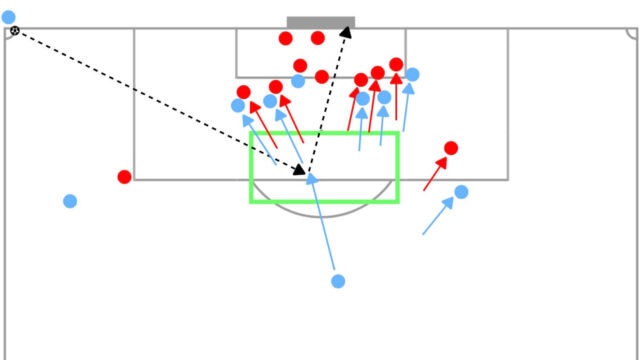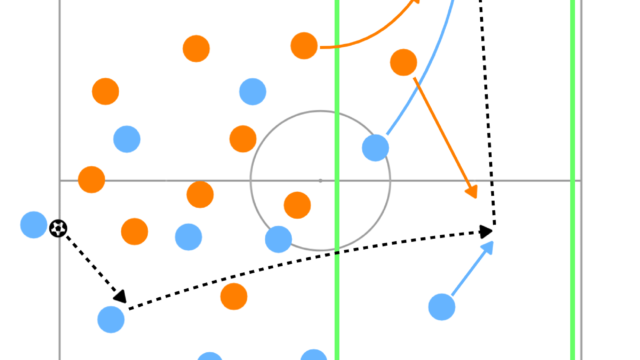What Is Throw-in? [Liverpool Throw-in Tactics]

Introduction
Throw-in is probably the most underrated set pieces in a game. The reason could be that many people think throw-in is less irrelevant to scoring or conceding goals than corner kicks or free kicks, but actually this is not true. Last season, Liverpool lost the Champions League final by the goal from throw-in. Liverpool made some mistakes when defending the throw-in and Real Madrid could create favourable 3v3 situation. Even though they conceded a crucial goal from mistakes of defending throw-in in the final, Liverpool is known for hiring throw-in coach, Thomas Gronnemark, and great at both attacking and defending throw-in. Therefore, in this article, Liverpool’s throw-in tactic is going to be analysed and it is tried to find out the principle of throw-in.
What Is Throw-in?
First of all, Liverpool’s idea of throw-in is going to be discussed. Basically, throw-in is not a set piece which creates ‘0 to 1’ but not try to make ‘0 to -1’. The reason is throw-in when both teams are ready is difficult to control and unpredictable because the ball thrown is very slow and short and many players try to win it. Additionally, in the situation where most of all players come close to the ball side, it is impossible to cover all space on the pitch and it can be exploited if some mistakes are made. In this kind of situation, it is difficult to play in the best way but it is possible to do in a better way. Therefore, it is possible to say that the principle of throw-in is ‘not making mistakes’ and ’force them to make mistakes’ in this kind of unpredictable situation. This is the basic of Liverpool’s throw-in tactics and they are going to be analysed in following chapters.
Attacking Throw-in
When talking about attacking throw-in tactics, it sometimes sounds like using some movements pattern to receive the ball. However, this is the second option of Liverpool’s throw-in tactics. The main option is throwing the ball in before the opposition players organise pressing. From the view of the principle of throw-in which is ‘not making mistakes’, throwing the ball backwards is much better than gambling. Especially, the fullback throws the ball to the centre back and restarts the game quickly.
Then, the option when the opposition team could organise their defence is going to be analysed. After failing to restart the game quickly, players need to think how to avoid a bad defensive transition. Of course, the best way is switching the ball into the opposite side or playing in behind. However, if it might be a risk to throw the ball in to feet, throwing the ball forward is a better option.
As it was discussed before, moving in some patterns to receive the ball is the second option. Additionally, Liverpool doesn’t have so many patterns of movements. Actually, what Liverpool does is moving in a pattern and the fullback can throw the ball whenever possible. In other words, the movement is same but the timing to throw the ball in is different.

This is the movement Liverpool uses when the opposition players organise the pressing. The first movement is made by the opposite side attacking midfielder. He runs past the defensive midfielder and lets him block the marker of the attacking midfielder to gain space and time. If he can successfully dismark the opposition defender, the fullback can throw the ball to him. Then, he can receive the ball to feet and play it into the opposite side or over the opposition defence line. On the other hand, if the attacking midfielder cannot dismark the opposition defender, the centre forward drops into the space made by the movements of the attacking midfielder and then, the winger comes into the space made by the movements of the centre forward. The fullback having the ball should find the right moment to throw it in. However, if he cannot do it or does not want to take any risks, he throws the ball forward because avoiding a bad defensive transition is their priority.
Defensive Throw-in
Compared with attacking throw-in, the aim of defensive throw-in is forcing the opponents to make mistakes. Liverpool tries to surround the ball by a few lines and lock them in.
The organisation looks like a below picture.

The width or height of each line can change based on where the ball will be thrown but organising three lines and surrounding the ball are same principle. Then, the role of each line is going to be analysed.
1st Line
The 1st line consists of the ball side winger, centre forward and attacking midfielder. The role is cutting the passing lanes from the thrower to the opposition players and preventing them from receiving the ball on their feet. This forces the opposition player to throw the ball in the air, which is difficult to control. Additionally, if the opposition player can receive the ball on feet, it is possible to play it into the opposite side or over the defence line. Therefore, preventing them from throwing the ball in safely is the objective of the 1st line.
2nd Line
The 2nd line consists of the ball side fullback, defensive midfielder, opposite side attacking midfielder and winger. The role is marking the opposition players and defending against the ball thrown over the players of 1st line. They only mark the opposition players behind the 1st line and after they move across the 1st line, they give the opposition players to the teammates of 1st line. Additionally, preventing them from switching the ball is also an important task. Especially, the opposite side winger and attacking midfielder need to press from outside and force them to play in the same side. However, Luis Díaz and Thiago Alcântara failed to complete this task and conceded that goal.
3rd Line
This final line consists of both centre backs and the opposite side fullback. The role is avoiding being exploited the space in behind and concede goals at all costs. Basically, they hardly step up to mark the opposition attackers and keep covering the space. If the ball is switched to the opposite side, they keep their line and delay the attack to take time for other players to come back.
These three lines force the opposition players to make mistakes and Liverpool can win the ball back. Of course, organising the three lines quicker than the opposition player throws the ball in is the most important thing in defending throw-in.
Conclusion
The most important thing is to avoid conceding a bad defensive transition and a goal. In order to do this, it is crucial to organise themselves quicker than the opposition team. Then, Liverpool has the solid organisation, which makes it easier for players to react every throw-in quicker. But they conceded the crucial goal in the final…


